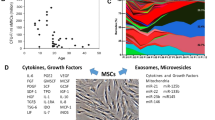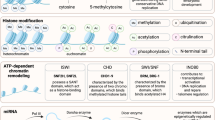Abstract
The field of stem cells and regenerative medicine offers considerable promise as a means of delivering new treatments for a wide range of diseases. In order to maximize the effectiveness of cell-based therapies — whether stimulating expansion of endogenous cells or transplanting cells into patients — it is essential to understand the environmental (niche) signals that regulate stem cell behaviour. One of those signals is from the extracellular matrix (ECM). New technologies have offered insights into how stem cells sense signals from the ECM and how they respond to these signals at the molecular level, which ultimately regulate their fate.
This is a preview of subscription content, access via your institution
Access options
Subscribe to this journal
Receive 12 print issues and online access
$189.00 per year
only $15.75 per issue
Buy this article
- Purchase on Springer Link
- Instant access to full article PDF
Prices may be subject to local taxes which are calculated during checkout



Similar content being viewed by others
References
Watt, F. M. & Driskell, R. R. The therapeutic potential of stem cells. Philos. Trans. R. Soc. B 365, 155–163 (2010).
Hynes, R. O. The extracellular matrix: not just pretty fibrils. Science 326, 1216–1219 (2009).
Hynes, R. O. Integrins: bidirectional, allosteric signaling machines. Cell 110, 673–687 (2002).
Puklin-Faucher, E. & Sheetz, M. P. The mechanical integrin cycle. J. Cell Sci. 122, 179–186 (2009).
Hall, P. A. & Watt, F. M. Stem cells: the generation and maintenance of cellular diversity. Development 106, 619–633 (1989).
Hay, E. D. Extracellular matrix. J. Cell Biol. 91, 205s–223s (1981).
Baker, B. M. & Chen, C. S. Deconstructing the third dimension — how 3D culture microenvironments alter cellular cues. J. Cell Sci. 125, 1–10 (2012).
Watt, F. M. & Fujiwara, H. Cell–extracellular matrix interactions in normal and diseased skin. Cold Spring Harb. Perspect. Biol. 3, a005124 (2011).
Piwko-Czuchra, A. et al. β1 integrin-mediated adhesion signalling is essential for epidermal progenitor cell expansion. PLoS ONE 4, e5488 (2009).
Ferreira, M., Fujiwara, H., Morita, K. & Watt, F. M. An activating β1 integrin mutation increases conversion of benign to malignant skin tumors. Cancer Res. 69, 1334–1342 (2009).
O'Neill, C., Jordan, P. & Ireland, G. Evidence for two distinct mechanisms of anchorage stimulation in freshly explanted and 3T3 Swiss mouse fibroblasts. Cell 44, 489–496 (1986).
Watt, F. M., Jordan, P. W. & O'Neill, C. H. Cell shape controls terminal differentiation of human epidermal keratinocytes. Proc. Natl Acad. Sci. USA 85, 5576–5580 (1988).
Théry, M. et al. Anisotropy of cell adhesive microenvironment governs cell internal organization and orientation of polarity. Proc. Natl Acad. Sci. USA 103, 19771–19776 (2006).
Connelly, J. T. et al. Actin and serum response factor transduce physical cues from the microenvironment to regulate epidermal stem cell fate decisions. Nature Cell Biol. 12, 711–718 (2010).
McBeath, R., Pirone, D. M., Nelson, C. M., Bhadriraju, K. & Chen, C. S. Cell shape, cytoskeletal tension, and RhoA regulate stem cell lineage commitment. Dev. Cell 6, 483–495 (2004).
Kilian, K. A., Bugarija, B., Lahn, B. T. & Mrksich, M. Geometric cues for directing the differentiation of mesenchymal stem cells. Proc. Natl Acad. Sci. USA 107, 4872–4877 (2010).
Watt, F. M. & Hogan, B. L. M. Out of Eden: stem cells and their niches. Science 287, 1427–1430 (2000).
Goulas, S., Conder, R. & Knoblich, J. A. The Par complex and integrins direct asymmetric cell division in adult intestinal stem cells. Cell Stem Cell 11, 529–540 (2012).
Rocheteau, P., Gayraud-Morel, B., Siegl-Cachedenier, I., Blasco, M. A. & Tajbakhsh, S. A subpopulation of adult skeletal muscle stem cells retains all template DNA strands after cell division. Cell 148, 112–125 (2012).
Théry, M. et al. The extracellular matrix guides the orientation of the cell division axis. Nature Cell Biol. 7, 947–953 (2005).
Lu, P., Weaver, V. M. & Werb, Z. The extracellular matrix: a dynamic niche in cancer progression. J. Cell Biol. 196, 395–406 (2012).
Engler, A. J., Sen, S., Sweeney, H. L. & Discher, D. E. Matrix elasticity directs stem cell lineage specification. Cell 126, 677–689 (2006).
Gilbert, P. M. et al. Substrate elasticity regulates skeletal muscle stem cell self-renewal in culture. Science 329, 1078–1081 (2010).
Saha, K. et al. Substrate modulus directs neural stem cell behavior. Biophys. J. 95, 4426–4438 (2008).
Hadjipanayi, E., Brown, R. A. & Mudera, V. Interface integration of layered collagen scaffolds with defined matrix stiffness: implications for sheet-based tissue engineering. J. Tissue Eng. Regen. Med. 3, 230–241 (2009).
Jha, A. K., Xu, X., Duncan, R. L. & Jia, X. Controlling the adhesion and differentiation of mesenchymal stem cells using hyaluronic acid-based, doubly crosslinked networks. Biomaterials 32, 2466–2478 (2011).
Nam, J., Johnson, J., Lannutti, J. J. & Agarwal, S. Modulation of embryonic mesenchymal progenitor cell differentiation via control over pure mechanical modulus in electrospun nanofibers. Acta Biomater. 7, 1516–1524 (2011).
Evans, N. D. et al. Substrate stiffness affects early differentiation events in embryonic stem cells. Eur. Cell Mater. 18, 1–13 (2009).
Wang, P. Y., Tsai, W. B. & Voelcker, N. H. Screening of rat mesenchymal stem cell behaviour on polydimethylsiloxane stiffness gradients. Acta Biomater. 8, 519–530 (2012).
Buxboim, A., Rajagopal, K., Brown, A. E. & Discher, D. E. How deeply cells feel: methods for thin gels. J. Phys. Condens. Matter. 22, 194116 (2010).
Franck, C., Maskarinec, S. A., Tirrell, D. A. & Ravichandran, G. Three-dimensional traction force microscopy: a new tool for quantifying cell–matrix interactions. PLoS ONE 6, e17833 (2011).
Trappmann, B. et al. Extracellular-matrix tethering regulates stem-cell fate. Nature Mater. 11, 642–649 (2012).
Engler, A. et al. Substrate compliance versus ligand density in cell on gel responses. Biophys. J. 86, 617–628 (2004).
Gaudet, C. et al. Influence of type I collagen surface density on fibroblast spreading, motility, and contractility. Biophys. J. 85, 3329–3335 (2003).
Wang, X. & Ha, T. Defining single molecular forces required to activate integrin and Notch signaling. Science 340, 991–994 (2013).
Mei, Y. et al. Combinatorial development of biomaterials for clonal growth of human pluripotent stem cells. Nature Mater. 9, 768–778 (2010).
Saha, K. et al. Surface-engineered substrates for improved human pluripotent stem cell culture under fully defined conditions. Proc. Natl Acad. Sci. USA 108, 18714–18719 (2011).
Oh, S. et al. Stem cell fate dictated solely by altered nanotube dimension. Proc. Natl Acad. Sci. USA 106, 2130–2135 (2009).
Unadkat, H. V. et al. An algorithm-based topographical biomaterials library to instruct cell fate. Proc. Natl Acad. Sci. USA 108, 16565–16570 (2011).
Brizzi, M. F., Tarone, G. & Defilippi, P. Extracellular matrix, integrins, and growth factors as tailors of the stem cell niche. Curr. Opin. Cell Biol. 24, 645–651 (2012).
Huebsch, N. et al. Harnessing traction-mediated manipulation of the cell/matrix interface to control stem-cell fate. Nature Mater. 9, 518–526 (2010).
Khetan, S. et al. Degradation-mediated cellular traction directs stem cell fate in covalently crosslinked three-dimensional hydrogels. Nature Mater. 12, 458–465 (2013).
Alves da Silva, M. L. et al. Chondrogenic differentiation of human bone marrow mesenchymal stem cells in chitosan-based scaffolds using a flow-perfusion bioreactor. J. Tissue Eng. Regen. Med. 5, 722–732 (2011).
Gobaa, S. et al. Artificial niche microarrays for probing single stem cell fate in high throughput. Nature Methods 8, 949–955 (2011).
Storm, C., Pastore, J. J., MacKintosh, F. C., Lubensky, T. C. & Janmey, P. A. Nonlinear elasticity in biological gels. Nature 435, 191–194 (2005).
Lin, Y.-C. et al. Origins of elasticity in intermediate filament networks. Phys. Rev. Lett. 104, 058101 (2010).
Discher, D. E., Janmey, P. & Wang, Y. L. Tissue cells feel and respond to the stiffness of their substrate. Science 310, 1139–1143 (2005).
Prager-Khoutorsky, M. et al. Fibroblast polarization is a matrix-rigidity dependent process controlled by focal adhesion mechanosensing. Nature Cell Biol. 13, 1457–1465 (2011).
Plotnikov, S. V., Pasapera, A. M., Sabass, B. & Waterman, C. M. Force fluctuations within focal adhesions mediate ECM-rigidity sensing to guide directed cell migration. Cell 151, 1513–1527 (2012).
Guvendiren, M. & Burdick, J. A. Stiffening hydrogels to probe short- and long-term cellular responses to dynamic mechanics. Nature Commun. 3, 792 (2012).
Young, J. L. & Engler, A. J. Hydrogels with time-dependent material properties enhance cardiomyocyte differentiation in vitro. Biomaterials 32, 1002–1009 (2011).
Mammoto, A., Mammoto, T. & Ingber, D. E. Mechanosensitive mechanisms in transcriptional regulation. J. Cell Sci. 125, 3061–3073 (2012).
Baarlink, C., Wang, H. & Grosse, R. Nuclear actin network assembly by formins regulates the SRF coactivator MAL. Science 340, 864–867 (2013).
Connelly, J. T., Mishra, A., Gautrot, J. E. & Watt, F. M. Shape-induced terminal differentiation of human epidermal stem cells requires p38 and is regulated by histone acetylation. PLoS ONE 6, e27259 (2011).
Wozniak, M. A. et al. Adhesion regulates MAP kinase/ternary complex factor exchange to control a proliferative transcriptional switch. Curr. Biol. 22, 2017–2026 (2012).
Dupont, S. et al. Role of YAP/TAZ in mechanotransduction. Nature 474, 179–183 (2011).
Mulder, K. W. et al. Diverse epigenetic strategies interact to control epidermal differentiation. Nature Cell Biol. 14, 753–763 (2012).
Tan, D. W. M. et al. Single cell gene expression profiling reveals functional heterogeneity of undifferentiated human epidermal cells. Development 140, 1433–1444 (2013).
Badylak, S. F., Weiss, D. J., Caplan, A. & Macchiarini, P. Engineered whole organs and complex tissues. Lancet 379, 943–952 (2012).
Huh, D. et al. Reconstituting organ-level lung functions on a chip. Science 328, 1662–1668 (2010).
Hoffman, B. D., Grashoff, C. & Schwartz, M. A. Dynamic molecular processes mediate cellular mechanotransduction. Nature 475, 316–323 (2011).
Paszek, M. J. et al. Scanning angle interference microscopy reveals cell dynamics at the nanoscale. Nature Methods 9, 825–827 (2012).
Grashoff C. et al. Measuring mechanical tension across vinculin reveals regulation of focal adhesion dynamics Nature 466, 263–266 (2010).
Legant, W. R. et al. Measurement of mechanical tractions exerted by cells in three-dimensional matrices. Nature Methods 7, 969–971 (2010).
Legant, W. R. et al. Multidimensional traction force microscopy reveals out-of-plane rotational moments about focal adhesions. Proc. Nat. Acad. Sci. USA 110, 881–886 (2013).
Fu, J. et al. Mechanical regulation of cell function with geometrically modulated elastomeric substrates. Nature Methods 7, 733–736 (2010).
Acknowledgements
The authors gratefully acknowledge the financial support of the Wellcome Trust (to F.M.W.), the Medical Research Council (to F.M.W.), Leverhulme Trust (to W.T.S.H.) and the European Research Council (W.T.S.H.). They also thank all past and present members of their laboratories who have participated in their collaboration.
Author information
Authors and Affiliations
Corresponding authors
Ethics declarations
Competing interests
The authors declare no competing financial interests.
Related links
Glossary
- Asymmetric cell division
-
A cell division that results in two daughter cells adopting different fates.
- Articular cartilage
-
Cartilage that covers the ends of joints.
- Elastic modulus
-
Mathematical description of the tendency of an object or substance to be deformed non-permanently when a force is applied to it.
- Formins
-
A family of formin homology proteins that are involved in actin polymerization.
- Fluorescence resonance energy transfer sensor
-
(FRET sensor). Tool that uses FRET to visualize protein interactions by light microscopy.
- Linear elasticity theory
-
Mathematical study of how solid objects deform and become internally stressed under prescribed loading conditions.
Rights and permissions
About this article
Cite this article
Watt, F., Huck, W. Role of the extracellular matrix in regulating stem cell fate. Nat Rev Mol Cell Biol 14, 467–473 (2013). https://doi.org/10.1038/nrm3620
Published:
Issue Date:
DOI: https://doi.org/10.1038/nrm3620
This article is cited by
-
Human apical-out nasal organoids reveal an essential role of matrix metalloproteinases in airway epithelial differentiation
Nature Communications (2024)
-
Snake venom-defined fibrin architecture dictates fibroblast survival and differentiation
Nature Communications (2023)
-
Fabrication of micro-nano patterned materials mimicking the topological structure of extracellular matrix for biomedical applications
Nano Research (2023)
-
Enhancing Viability of Human Embryonic Stem Cells during Cryopreservation via RGD-REP-Mediated Activation of FAK/AKT/FoxO3a Signaling Pathway
Tissue Engineering and Regenerative Medicine (2023)
-
The role of extracellular matrix on unfavorable maternal–fetal interface: focusing on the function of collagen in human fertility
Journal of Leather Science and Engineering (2022)



